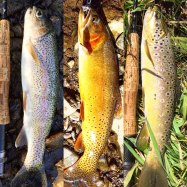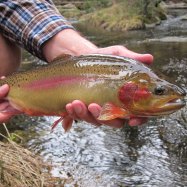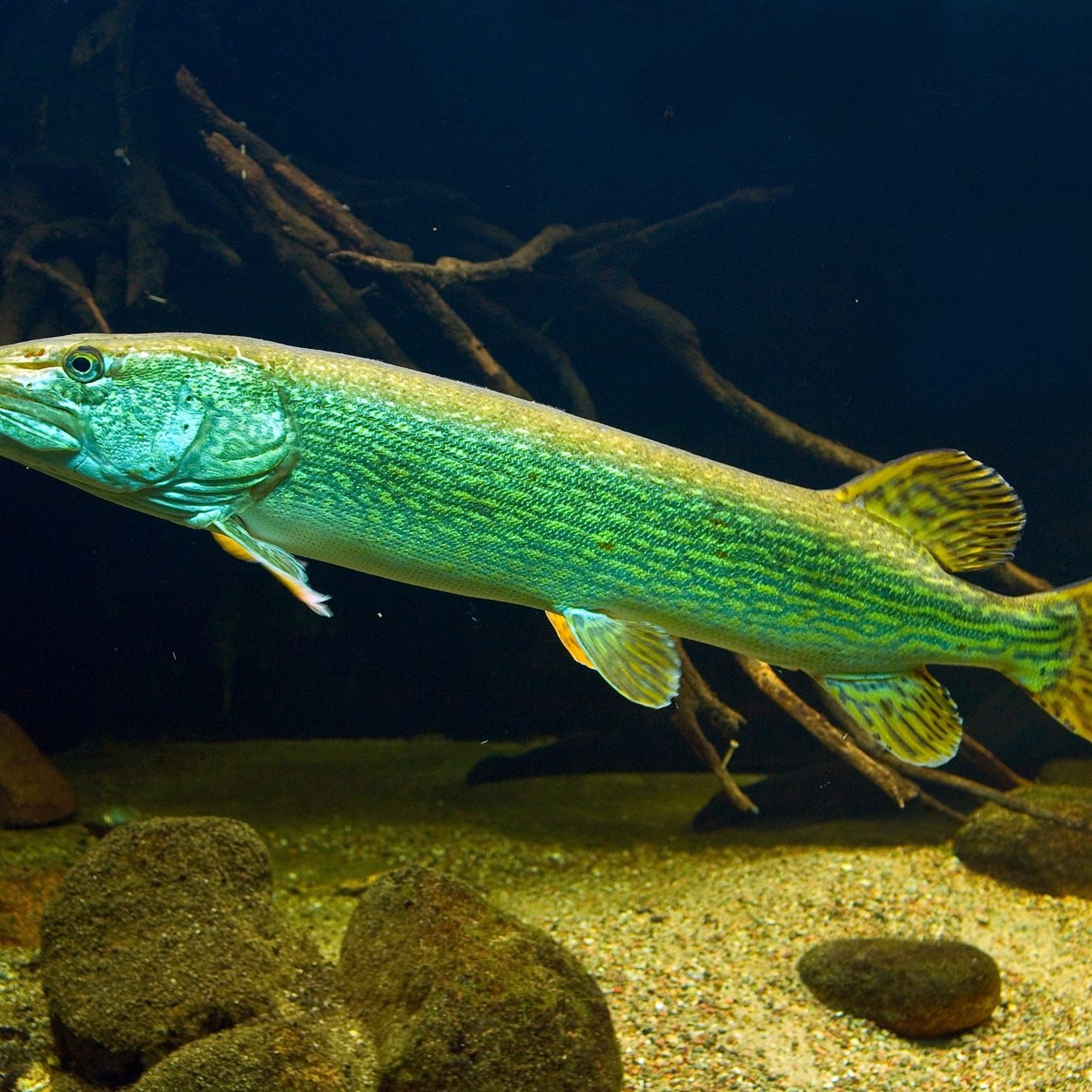
Pike Fish
Up to 1.4 meters (4.6 feet)
The pike fish, also known as the water wolf, is a fierce predator found in lakes, rivers, and streams. With a body shape resembling a torpedo and reaching up to 1.4 meters in length, it is a formidable sight to behold. Belonging to the Esocidae family, the pike fish is a popular game fish among anglers for its challenging fight and delicious flavor.
Animal Details Summary:
Common Name: Pike Fish
Kingdom: Animalia
Habitat: Freshwater
The Mighty Pike Fish: Top Carnivore of Freshwater Habitats
The pike fish, scientifically known as Esox lucius, is a top predator in freshwater habitats. Its common name, pike fish, refers to its elongated, torpedo-shaped body and its fierce and predatory nature. It belongs to the Kingdom Animalia, Phylum Chordata, Class Actinopterygii, and Order Esociformes. The pike fish is a member of the Esocidae family, and it is found in lakes, rivers, and streams in North America, Europe, and Asia Pike Fish. Its natural habitat is in the Northern Hemisphere, and it is known for its greenish-brown coloration with dark vertical bars. This article will delve into the fascinating world of the mighty pike fish, exploring its habitat, feeding habits, physical attributes, and unique features.Habitat and Distribution
The pike fish is a highly adaptable species found in a variety of habitats, including lakes, rivers, and streams. It is a freshwater fish and can survive in both standing and running water, making it one of the most widely distributed fish species in the world. The pike fish is native to the Northern Hemisphere, and it is found in lakes and rivers in countries such as Canada, the United States, Russia, and China.Pike fish are primarily found in North America, Europe, and Asia, but they have been introduced to other regions, such as Australia and New Zealand, as well. They are a popular game fish and are often introduced to new areas for recreational fishing. However, this has led to concerns about the impact on native fish populations, as they can be aggressive predators and can disrupt the natural balance in ecosystems.
Feeding Habits
The pike fish is a carnivorous species, and its diet consists mainly of other fish, but it is known to also prey on small mammals, birds, and amphibians Potato Beetle. They have sharp teeth and a powerful jaw that allows them to grasp and hold onto their prey. They are opportunistic feeders, meaning they will eat whatever is available, and they have a voracious appetite, consuming up to 4 times their body weight in a year.Pike fish have excellent vision, allowing them to spot their prey from a distance, and they are also equipped with a unique sensory system called the lateral line, which helps them detect vibrations in the water. This makes them efficient hunters, able to stalk and ambush their prey with precision. They are also known for their aggressive nature, often attacking and killing prey larger than themselves.
Physical Attributes
The pike fish is one of the largest freshwater fish species, with some individuals reaching lengths of up to 1.4 meters (4.6 feet). They have an elongated, torpedo-shaped body, which is ideal for swift and powerful swimming. Their body is covered in small, overlapping scales, which helps protect them from predators and reduces friction in the water. This smooth and streamlined body shape, combined with their strong caudal (tail) fin, allows them to move through the water with ease.Perhaps the most distinctive feature of the pike fish is its powerful jaws and sharp teeth. They have a large mouth filled with sharp, canine-like teeth that are designed for gripping and tearing flesh. These teeth are continually growing, allowing the pike fish to maintain its predatory advantage at all times. Their coloring also plays a crucial role in their hunting strategy. The greenish-brown coloration with dark vertical bars helps them to blend in with their surroundings, making them almost invisible to prey.
Adaptations for Survival
As a top predator in its habitat, the pike fish has evolved several unique adaptations to ensure its survival. The first is its size, as the larger individuals have an advantage over smaller prey and can also compete with larger predators. Their sharp teeth and powerful jaws also give them an edge in hunting, as they can quickly subdue and consume their prey.Another interesting adaptation of the pike fish is its ability to regulate its buoyancy. Like most fish, the pike fish has an air bladder, which helps it maintain its position in the water. However, the pike fish can also use this air bladder to adjust its buoyancy, allowing it to float in place, swim at different depths, or even rise to the surface to gulp air.
Pike fish are also known for their ability to survive in different water conditions. They can tolerate low oxygen levels in the water and even breathe air if necessary. This is useful for surviving in stagnant or overcrowded waters, where oxygen levels may be low. This adaptation gives them an advantage over other fish species, allowing them to thrive in a wide range of habitats.
Importance to the Ecosystem
As top predators in their ecosystem, pike fish play a vital role in maintaining the balance of the food chain. They help regulate the population of their prey, thus preventing overpopulation and maintaining a healthy ecosystem. They also provide a food source for larger predators, such as birds and mammals, and contribute to the overall biodiversity of their habitat.In addition to their ecological importance, pike fish also have economic significance. They are a popular game fish, sought after by recreational anglers for their size and fighting spirit. Pike fish fishing has become a lucrative business in many regions, and it contributes significantly to the economy. However, conservation efforts are necessary to ensure the sustainability of this industry and prevent overfishing.
In Conclusion
In conclusion, the pike fish is a magnificent and highly adaptable species that has fascinated humans for centuries. Its predatory nature, unique physical attributes, and important role in its ecosystem make it a remarkable creature worth learning about and admiring. As conservation efforts continue, we hope to maintain a healthy balance in ecosystems and continue to appreciate the incredible species that call our freshwater habitats home. We must also remember to respect and protect their natural habitats, so future generations can continue to learn about and appreciate the mighty pike fish.

Pike Fish
Animal Details Pike Fish - Scientific Name: Esox lucius
- Category: Animals P
- Scientific Name: Esox lucius
- Common Name: Pike Fish
- Kingdom: Animalia
- Phylum: Chordata
- Class: Actinopterygii
- Order: Esociformes
- Family: Esocidae
- Habitat: Freshwater
- Feeding Method: Carnivorous
- Geographical Distribution: North America, Europe, and Asia
- Country of Origin: Northern Hemisphere
- Location: Lakes, rivers, and streams
- Animal Coloration: Greenish-brown with dark vertical bars
- Body Shape: Elongated, torpedo-shaped
- Length: Up to 1.4 meters (4.6 feet)
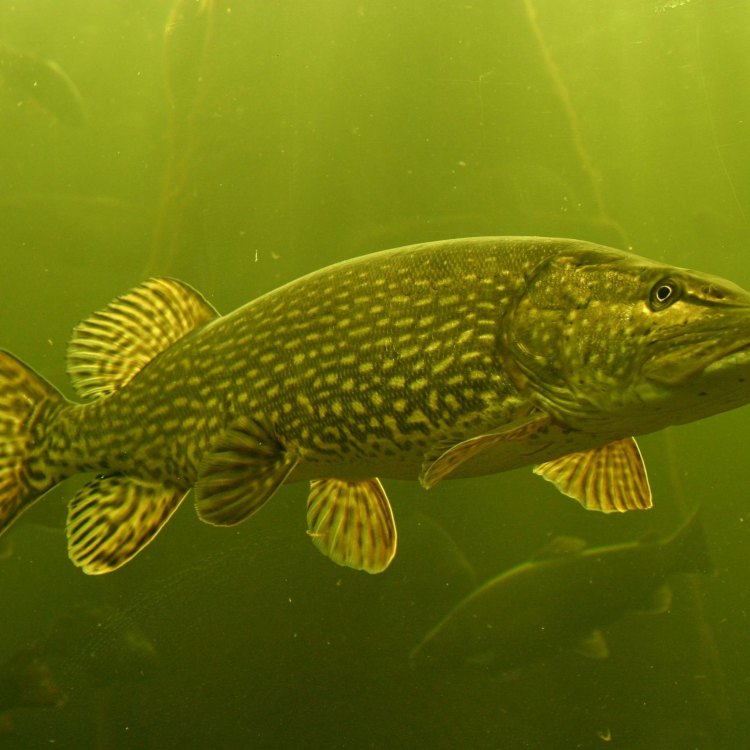
Pike Fish
- Adult Size: Up to 15 kilograms (33 pounds)
- Average Lifespan: 10-20 years
- Reproduction: Sexual
- Reproductive Behavior: Spawning
- Sound or Call: None
- Migration Pattern: Migratory
- Social Groups: Usually solitary
- Behavior: Ambush predators, hiding among vegetation or near structure
- Threats: Overfishing, habitat loss, pollution
- Conservation Status: Least Concern
- Impact on Ecosystem: Top predator, helps maintain balance in freshwater ecosystems
- Human Use: Sport fishing, food
- Distinctive Features: Long, sharp teeth, elongated body, spotted appearance
- Interesting Facts: They can consume prey as large as themselves, have a torpedo-like body shape for fast swimming, and can survive in low-oxygen environments
- Predator: Bigger fish, birds of prey
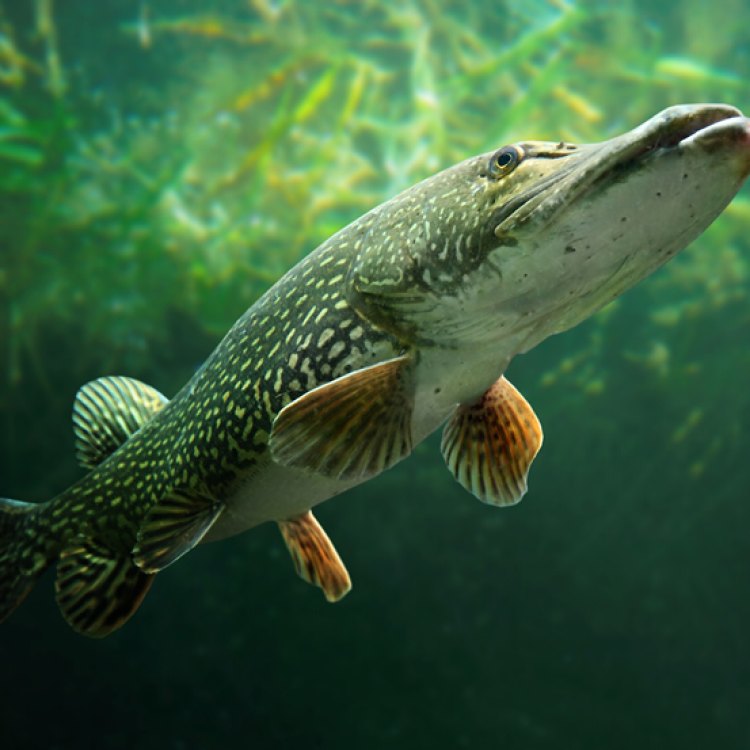
Esox lucius
The Mighty Pike Fish: A Top Predator in Freshwater Ecosystems
When we think of the world's top predators, we often picture fierce animals like lions, tigers, and wolves. But there is a lesser-known predator lurking beneath the surface of freshwater ecosystems – the mighty Pike fish.Pike fish, also known as Northern Pike, are a common sight in lakes, rivers, and streams across North America, Europe, and Asia. They are a large, predatory fish with distinctive features that make them stand out from other fish species PeaceOfAnimals.Com. In this article, we will dive into the world of Pike fish, exploring their unique characteristics, behavior, and role in the ecosystem.
The Basics: Adult Size, Lifespan, and Reproduction
Pike fish are impressive creatures that can grow up to 15 kilograms (33 pounds) in weight and reach lengths of over 1.5 meters (5 feet). They are the largest species in the Esocidae family, which also includes muskellunge and pickerel.On average, Pike fish live for 10-20 years in the wild, although some have been known to surpass the 25-year mark. These long lifespans are thanks in part to their impressive reproductive abilities. Pike fish are sexual reproducers, meaning they need a male and female to mate and produce offspring. They are also known for their rapid growth rate, reaching maturity within two to three years.
Reproductive Behavior: Spawning
Pike fish are not just impressive in size and lifespan; they also have a unique reproductive behavior Pterodactyl. During the spring months, Pike fish migrate to shallow areas, such as marshes and wetlands, to spawn. The females lay thousands of eggs, which the males then fertilize. The eggs are sticky and adhere to vegetation, rocks, or other structures to protect them.After spawning, the parents return to deeper waters, leaving the eggs to hatch within a week. The offspring, called fry, grow quickly and can reach a size of 15-20 cm (6-8 inches) within a few months.
Behavior: Ambush Predators and Solitary Creatures
Pike fish are ambush predators, meaning they use their hiding skills to capture their prey. They are skilled at blending into their surroundings, using vegetation and structures to hide and surprise unsuspecting prey. Their sharp, elongated teeth allow them to easily grab and hold onto their prey, making them formidable hunters.These fish are also known for their solitary behavior, with each adult Pike fish typically occupying its own territory. They are most active during dawn and dusk, using their sharp vision to hunt their prey under low light conditions. However, during the spawning season, they become more social, gathering in shallow waters to reproduce.
Migratory Patterns and Adaptation to Low-Oxygen Environments
Although Pike fish are genetically similar to other Esocidae species, they differ in their migratory patterns. While muskellunge and pickerel are more sedentary, Pike fish are known for their annual migrations. They move from deeper, colder waters to shallow, warmer areas, and back again, following their food sources and reproductive instincts.Another fascinating feature of Pike fish is their ability to adapt to low-oxygen environments. They have a labyrinth of chambers in their gills that allow them to extract oxygen from the water efficiently. This ability enables them to survive in stagnant waters and still hunt for their prey, giving them a competitive advantage in various freshwater habitats.
Distinctive Features: Teeth, Body Shape, and Spotted Appearance
One of the most notable features of Pike fish is their long and sharp teeth. These teeth are designed for grasping and holding onto their prey, making them formidable predators. Pike fish are also easily recognizable by their torpedo-like body shape, which is designed for fast swimming and quick maneuvering. Their elongated body allows them to reach impressive speeds of up to 60 km/h (37mph).In addition to their teeth and shaped body, Pike fish also have a unique spotted appearance. Their coloration can range from olive-green to dark bronze, with lighter spots all over their body. These spots serve as camouflage, helping them blend into their surroundings while they hunt.
Human Use: Sport Fishing and Food
Pike fish may be top predators in the ecosystem, but they are also highly valued by humans. They are a popular sport fish, providing an exhilarating challenge for anglers. Pike fish are also caught and sold commercially for food, with their mild-tasting, white flesh highly sought after by many.Despite their popularity, Pike fish still face numerous threats, including overfishing, habitat loss, and water pollution. These factors are causing a decline in their populations in some areas, leading to concerns for their long-term survival.
Impact on the Ecosystem
As top predators, Pike fish play a crucial role in maintaining the balance of freshwater ecosystems. They help control the populations of their prey, preventing overgrazing and promoting a healthy ecosystem. In areas where Pike fish populations have decreased, there has been a noticeable increase in the number of smaller fish species, causing a ripple effect down the food chain.Predators and Interesting Facts
While Pike fish may be at the top of the food chain, they are not entirely immune from predation. Larger fish and birds of prey, such as Bald Eagles and Ospreys, are known to prey on Pike fish. However, their elusive nature and sharp senses often keep them safe from predators.One of the most interesting facts about Pike fish is their ability to consume prey as large as themselves. They are opportunistic feeders, meaning they will eat pretty much anything that crosses their path, from smaller fish to waterfowl and even small mammals. This trait, along with their impressive hunting skills, makes them an essential part of the ecosystem.
Final Thoughts
Pike fish may not be the most well-known or celebrated species, but they are undoubtedly fascinating creatures. Their distinctive features, behaviors, and role in the ecosystem make them stand out as top predators in freshwater environments. From their sharp teeth and elongated bodies to their unique reproductive behaviors and adaptability, Pike fish continue to astound and amaze both scientists and nature enthusiasts. As we strive to protect and conserve our planet's diverse ecosystems, let us not forget the essential role that Pike fish play in the natural world.
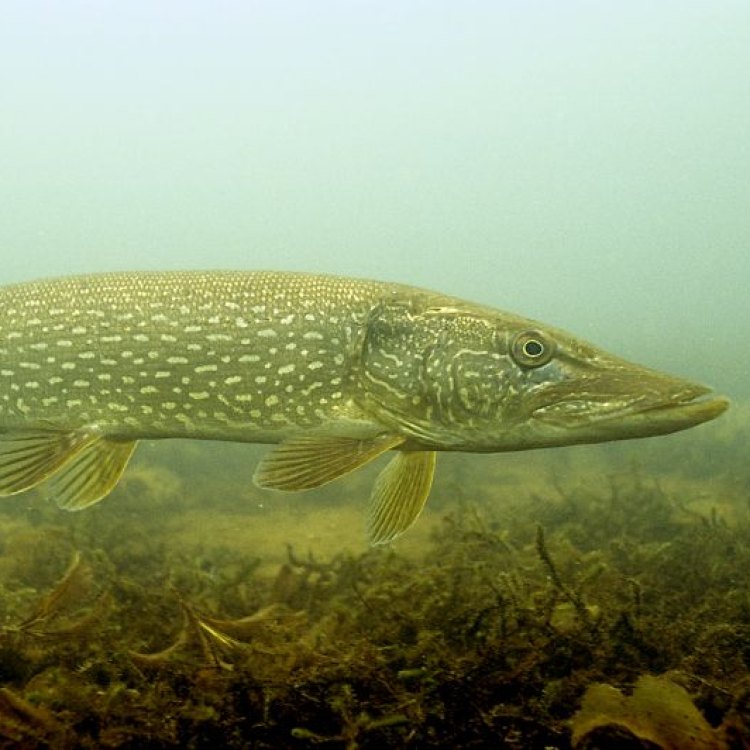
The Mighty Pike Fish: Top Carnivore of Freshwater Habitats
Disclaimer: The content provided is for informational purposes only. We cannot guarantee the accuracy of the information on this page 100%. All information provided here may change without prior notice.




